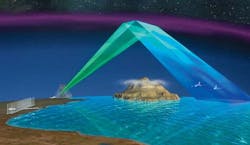Navy asks Raytheon to operate and maintain ROTHR over-the-horizon surveillance radar
Officials of the Naval Supply Systems Command Fleet Logistics Center Norfolk announced a $20.9 million contract in late March to the Raytheon Intelligence, Information, and Services (IIS) segment in Dulles, Va., to operate and maintain Relocatable Over-The-Horizon Radar (ROTHR) sites in Chesapeake, Va., and Corpus Christi, Texas.
The ROTHR over-the-horizon radar uses high-frequency radar waves that bounce off a layer of the atmosphere called the ionosphere to provide long-range over-the-horizon radar coverage. It achieves long ranges just like shortwave radio.
ROTHR uses HF radio waves, which are particularly susceptible to interference from lightning almost anywhere in the world. HF signal reception also changes throughout the course of the day and the seasons, as well as at night, so ROTHR poses a particularly difficult digital signal processing (DSP) problem.
Related: Pinpointing covert HF transmitters worldwide is goal of HFGeo signals intelligence program
Raytheon's contract will support the Navy Forces Surveillance Support Center in Chesapeake, Va. Awarding the contract were officials of the Norfolk center's contracting department in Philadelphia. This contract has a one year base and four one-year option that could increase its value to $104.9 million.
ROTHR is designed to provide early warning of strikes against aircraft carrier task forces, and is suited especially for long-range surveillance of large open-water areas out to ranges as far as 2,500 nautical miles.
As their name implies, the ROTHR systems can be moved, and have been redeployed for detection and monitoring of air traffic in the U.S. government's war against drugs, Raytheon officials say.
The ROTHR system has been operational with the U.S. government for more than 25 years, supporting the counter drug mission in the Caribbean and South America, and early warning detection for Navy vessels at sea.
Related: Raytheon to continue work on aerostat-based cruise missile defense system
Each radar provides more than 2.5 million square miles of coverage and detects more than 350,000 targets per year. It is currently the U.S. government's primary surveillance system for the counter-drug mission, Raytheon officials say.
Raytheon has been upgrading the radars since the initial installations to improve performance and reliability. Performance improvements included state of the art computers and displays and enhanced software for more accurate tracking of small aircraft and boats.
On this contract Raytheon will do the work in Chesapeake, Va.; Pounce, Puerto Rico; Premont, Texas; Vieques, Puerto Rico; New Kent, Va.; and Freer, Texas, and should be finished by April 2017 at the earliest, and by April 2021 at the latest.
For more information contact the Naval Supply Systems Command Fleet Logistics Center Norfolk at www.navsup.navy.mil, or Raytheon Intelligence, Information, and Services at www.raytheon.com.
